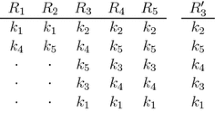Abstract
Bogomolnaia and Moulin (J Econ Theory 100:295–328, 2001) show that there is no rule satisfying stochastic dominance efficiency,equal treatment of equals and stochastic dominance strategy-proofness for a probabilistic assignment problem of indivisible objects. Recently, Mennle and Seuken (Partial strategyproofness: relaxing strategy-proofness for the random assignment problem. Mimeo, 2017) show that stochastic dominance strategy-proofness is equivalent to the combination of three axioms, swap monotonicity,upper invariance, and lower invariance. In this paper, we introduce a weakening of stochastic dominance strategy-proofness, called upper-contour strategy-proofness, which requires that if the upper-contour sets of some objects are the same in two preference relations, then the sum of probabilities assigned to the objects in the two upper-contour sets should be the same. First, we show that upper-contour strategy-proofness is equivalent to the combination of two axioms, upper invariance and lower invariance. Next, we show that the impossibility result still holds even though stochastic dominance strategy-proofness is weakened to upper-contour strategy-proofness.
Similar content being viewed by others
Notes
Related impossibility results are given in Chang and Chun (2017), Kasajima (2013), Liu and Zeng (2019), Mennle and Seuken (2017), Nesterov (2017), and Zhou (1990). On the other hand, possibility results can be found in Bogomolnaia and Heo (2012), Bogomolnaia and Moulin (2002), Hashimoto et al. (2014), Heo (2014), and Heo and Yılmaz (2015).
Note that it is possible to have \(a = b\).
Agent 1 has to compare \(\varphi _{1a}(P^{1}_{1}, P_{2}, P_{3})\) with \(\varphi _{1a}(P^{2}_{1}, P_{2}, P_{3}),\)\(\varphi _{1a}(P^{3}_{1}, P_{2}, P_{3}),\)\(\varphi _{1a}(P^{4}_{1}, P_{2}, P_{3}),\)\(\varphi _{1a}(P^{5}_{1}, P_{2}, P_{3}),\) and \(\varphi _{1a}(P^{6}_{1}, P_{2}, P_{3}\)). Also, she has to compare \(\varphi _{1a}(P^{1}_{1}, P_{2}, P_{3}) + \varphi _{1b}(P^{1}_{1}, P_{2}, P_{3})\) with \(\varphi _{1a}(P^{2}_{1}, P_{2}, P_{3}) + \varphi _{1b}(P^{2}_{1}, P_{2}, P_{3}),\)\(\varphi _{1a}(P^{3}_{1}, P_{2}, P_{3}) + \varphi _{1b}(P^{3}_{1}, P_{2}, P_{3}),\)\(\varphi _{1a}(P^{4}_{1}, P_{2}, P_{3}) + \varphi _{1b}(P^{4}_{1}, P_{2}, P_{3}),\)\(\varphi _{1a}(P^{5}_{1}, P_{2}, P_{3}) + \varphi _{1b}(P^{5}_{1}, P_{2}, P_{3}),\) and \(\varphi _{1a}(P^{6}_{1}, P_{2}, P_{3}) + \varphi _{1b}(P^{6}_{1}, P_{2}, P_{3}\)).
Agent 1 has to compare \(\varphi _{1a}(P^{1}_{1}, P_{2}, P_{3})\) with \(\varphi _{1a}(P^{2}_{1}, P_{2}, P_{3})\) and \(\varphi _{1a}(P^{1}_{1}, P_{2}, P_{3})+\varphi _{1b}(P^{1}_{1}, P_{2}, P_{3})\) with \(\varphi _{1a}(P^{3}_{1}, P_{2}, P_{3})+\varphi _{1b}(P^{3}_{1}, P_{2}, P_{3})\).
Since \(\sum _{k=1}^{n-1}k!(n-k)! \le (n-1)(n-1)!,\) we have \(\frac{(n!-1)(n-1)}{\{\sum _{k=1}^{n-1}k!(n-k)!\} - (n-1)} \ge \frac{(n!-1)(n-1)}{(n-1)(n-1)! - (n-1)} = \frac{n! - 1}{(n-1)! - 1} = n \cdot \frac{(n-1)! - \frac{1}{n}}{(n-1)! - 1} \ge n\).
Ex-post efficiency requires that an allocation selected by a rule should be represented as a probability distribution over efficient deterministic allocations. Sd-efficiency implies ex-post efficiency, but the converse is not true.
Upper envy-freeness requires that if two agents have the same upper contour set for some object, then they should be assigned with the same probability of receiving the object. Formally, for each \(P \in \mathcal {P}^{N},\) each i, \(j \in N,\) and each \(a \in A,\) if \(U(P_{i},a) = U(P_{j},a),\) then \(\varphi _{ia}(P) = \varphi _{ja}(P)\). It is stronger than strong equal treatment of equals, but the converse is not true. The random serial dictator rule satisfies strong equal treatment of equals, but not upper envy-freeness.
As shown in Sato (2013) and Cho (2016), if the domain satisfies connectedness and non-restoration, then sd-adjacent strategy-proofness is equivalent to sd-strategy-proofness. Since our universal domain satisfies these two conditions, we can also establish the equivalence between uc-adjacent strategy-proofness and uc-strategy-proofness.
References
Bogomolnaia A, Heo EJ (2012) Probabilistic assignment of objects: characterizing the serial rule. J Econ Theory 147:2072–2082
Bogomolnaia A, Moulin H (2001) A new solution to the random assignment problem. J Econ Theory 100:295–328
Bogomolnaia A, Moulin H (2002) A simple random assignment problem with a unique solution. Econ Theor 19:623–635
Carroll G (2012) When are local incentive constraints sufficient? Econometrica 80(2):661–686
Chang H, Chun Y (2017) Probabilistic assignment of indivisible objects when agents have the same preferences except the ordinal ranking of one object. Math Soc Sci 90:80–92
Cho WJ (2016) Incentive properties for ordinal mechanisms. Games Econ Behav 95:168–177
Hashimoto T, Hirata D, Kesten O, Kurino M, Unver U (2014) Two axiomatic approaches to the probabilistic serial mechanism. Theor Econ 9:253–277
Heo EJ (2014) Probabilistic assignment problem with multi-unit demands: a generalization of the serial rule and its characterization. J Math Econ 54:40–47
Heo EJ, Yılmaz Ö (2015) A characterization of the extended serial correspondence. J Math Econ 59:102–110
Hylland A, Zeckhauser R (1979) The efficient allocation of individuals to positions. J Political Econ 87:293–314
Kasajima Y (2013) Probabilistic assignment of indivisible goods with single-peaked preferences. Soc Choice Welf 41:203–215
Liu P, Zeng H (2019) Random assignment on preference domains with a tier structure. J Math Econ 84:176–194
Mennle T, Seuken S (2017) Partial strategyproofness: relaxing strategy-proofness for the random assignment problem. Mimeo
Nesterov A (2017) Fairness and efficiency in strategy-proof object allocation mechanisms. J Econ Theory 170:145–168
Sato S (2013) A sufficient condition for the equivalence of strategy-proofness and nonmanipulability by preferences adjacent to the sincere one. J Econ Theory 148(1):259–278
Zhou L (1990) On a conjecture by Gale about one-sided matching problems. J Econ Theory 52:123–135
Author information
Authors and Affiliations
Corresponding author
Additional information
Publisher's Note
Springer Nature remains neutral with regard to jurisdictional claims in published maps and institutional affiliations.
We are grateful to Eun Jeong Heo and two reviewers for their comments. Chun’s work was supported by the National Research Foundation of Korea Grant funded by the Korean Government (NRF-2016S1A3A2924944) and the Center for Distributive Justice in the Institute of Economic Research of Seoul National University.
Rights and permissions
About this article
Cite this article
Chun, Y., Yun, K. Upper-contour strategy-proofness in the probabilistic assignment problem. Soc Choice Welf 54, 667–687 (2020). https://doi.org/10.1007/s00355-019-01226-1
Received:
Accepted:
Published:
Issue Date:
DOI: https://doi.org/10.1007/s00355-019-01226-1



